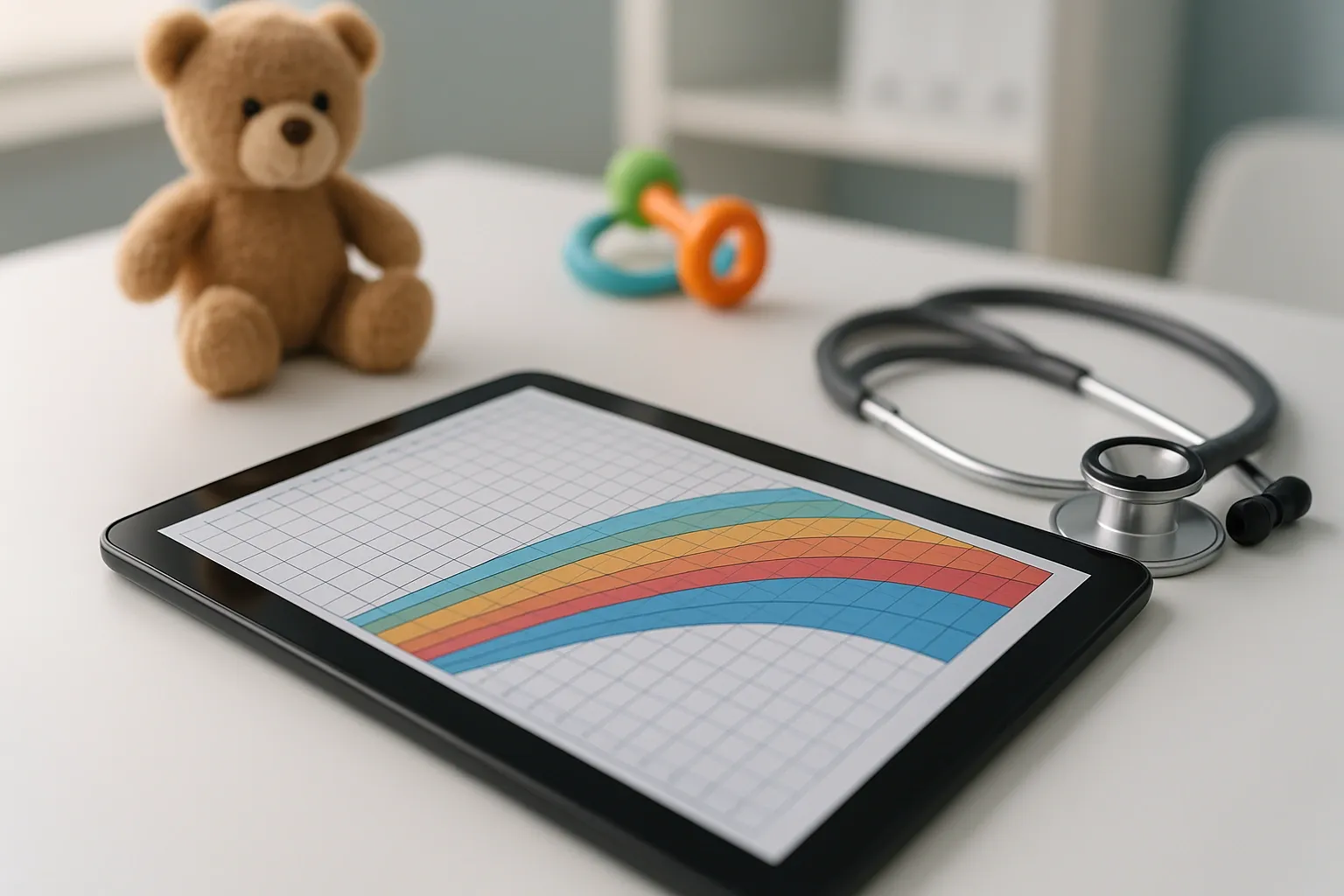
Monitoring a child’s growth is one of the most essential components of pediatric care. More than simply recording weight and height, tracking development helps identify early signs of endocrine, nutritional, neurological, genetic, or social concerns. In this process, the WHO Growth Charts serve as a global standard, offering population-based references that guide clinical decisions, support accurate assessments, and strengthen communication with families.
With the increasing digitalization of healthcare, growth monitoring is no longer an isolated action. Integrating WHO growth charts into an Electronic Health Record (EHR) enhances precision, reduces errors, and improves continuity of care. For clinics and pediatric practices, working with structured data, automated formulas, and visual historical records enables informed decisions and a more predictable workflow. In this article, we will explore how WHO Growth Charts are used in pediatric routines, why they matter, how the EHR elevates their accuracy, and how Ninsaúde Clinic provides a modern and secure way to track child development.
Before we continue, we need to ask: Are you already familiar with Ninsaúde Clinic? Ninsaúde Clinic is an intelligent software designed to simplify clinical management — combining an agile schedule, legally valid electronic health records, telemedicine, and complete financial control in one platform. Discover how Ninsaúde Clinic transforms daily operations and enhances patient care.

What Are WHO Growth Charts?
WHO Growth Charts are graphical tools that represent global growth patterns of children from birth to adolescence. They include reference curves for weight, height/length, BMI, and head circumference, separated by age and sex. Their percentiles — such as P3, P15, P50, P85, and P97 — help clinicians compare a child’s measurements with standardized international benchmarks.

Using these curves, pediatric professionals can identify:
- Expected growth patterns
- Risk of malnutrition or obesity
- Slowed weight gain
- Short stature trends
- Accelerated growth
- Early signs of underlying conditions
The WHO charts were created using robust international data and are continuously reviewed to align with updated scientific evidence. This makes them reliable for pediatric use in diverse populations worldwide.
Why Growth Charts Are Essential in Pediatric Care
Child growth is influenced by genetics, nutrition, environment, maternal health, and socioeconomic factors. Assessing only weight or height in isolation can lead to misinterpretations.
Growth charts support clinicians by enabling them to:
- Contextualize individual measurements within global norms
- Identify trends instead of isolated fluctuations
- Detect subtle early deviations that may indicate health concerns
- Guide diagnostic and therapeutic decisions
- Ensure consistent documentation for long-term care
The trajectory over time is more important than a single percentile point. For instance, a child who drops from the 50th to the 15th percentile may require evaluation for nutritional deficiencies, gastrointestinal disorders, or other conditions that need early intervention.

Interpreting Percentiles and Growth Trajectories
A proper interpretation involves understanding normal variations and recognizing meaningful changes:
Expected growth
A child follows a consistent percentile curve over time. Shifts within adjacent percentiles may be normal if gradual.
Nutritional risk
Sudden downward shifts in weight percentiles—especially during early infancy—serve as warning signs. They may reflect feeding challenges, malabsorption, food allergies, or chronic illness.
Short stature
Height persistently below the 3rd percentile may indicate endocrine issues, genetic syndromes, or chronic health conditions.
Accelerated growth
Rapid increases in weight or BMI percentiles may signal early risk for overweight or obesity.
Accurate interpretation requires consistent measurements and organized historical data—areas where digital systems make a dramatic difference.
The Importance of Electronic Health Records in Growth Monitoring
Traditional paper charts were often vulnerable to missing pages, inconsistent annotations, and limited longitudinal visibility. These limitations hindered accurate evaluation.
With a structured Electronic Health Record, the process becomes significantly more efficient:
Automated and precise data entry
Weight, height, head circumference, and BMI are entered into dedicated fields that automatically populate calculations and graphs.
Consistent longitudinal history
No lost papers, outdated measurements, or duplicated information. Clinicians can review months or years of growth instantly.
Built-in calculations and alerts
Modern systems calculate BMI, corrected age, percentiles, and z-scores automatically, minimizing human error.
Safer clinical decisions
Clear graphical evolution allows clinicians to detect deviations early, communicate effectively with caregivers, and justify interventions.
Collaborative care
Nutritionists, pediatric specialists, therapists, and other care providers can access the same standardized data, improving patient outcomes.
For medium and large clinics, digitalization is not only a convenience — it is essential for operational efficiency and clinical safety.
How Growth Tracking Works Inside Ninsaúde Clinic
Ninsaúde Clinic is designed to help pediatric practices streamline workflows, reduce manual processes, and centralize patient data. Its structured EHR transforms how growth charts are used in everyday pediatric care.

Ready-to-use and customizable pediatric forms
The platform includes pediatric templates with fields for weight, height, BMI, head circumference, and other key indicators. Clinics may also create custom forms with calculated fields based on their internal protocols.
Automated graph generation
Once data is entered, clinicians can visualize the child's growth history through clear, organized charts. There is no need for spreadsheets or manual plotting — the system does all the calculations internally.
Fully integrated clinical ecosystem
Pediatric growth monitoring works seamlessly with:
- electronic prescriptions
- clinical notes
- telemedicine appointments
- vaccine records
- exam attachments
- consent forms
- automated communication with families
Advanced pediatric protocol customization
Clinics can add scoring systems, developmental assessments, or nutritional evaluations that complement the growth analysis.
International usability and compliance
The platform operates in multiple languages and adheres to global privacy standards such as HIPAA-equivalent protections, ensuring secure handling of pediatric data.
Best Practices for Using Growth Charts in the Clinic
Technology supports the process, but clinical consistency is key:
1. Use proper measurement techniques
Well-calibrated scales and accurate stadiometers reduce variability.
2. Record measurements directly into the EHR
Avoid loose notes that lead to transcription errors.
3. Focus on patterns, not isolated values
Trends over time reflect the true picture of growth.
4. Use visuals to explain findings to caregivers
Graphs make communication clearer and more engaging.

5. Leverage historical data for preventive care
Early trends in BMI or growth velocity help identify potential risks before they escalate.
When combined with a modern EHR like Ninsaúde Clinic, these practices result in safer, more efficient pediatric monitoring.
The WHO Growth Charts are fundamental tools for monitoring healthy child development around the world. They guide clinical decisions, highlight risks, and support early diagnosis. However, their effectiveness depends heavily on consistent measurement, proper interpretation, and reliable documentation.
An Electronic Health Record — especially one as complete as Ninsaúde Clinic — elevates pediatric care by automating calculations, organizing historical data, and centralizing all information in a single system. From graphical visualization to integrated clinical workflows, the platform helps clinicians work with more accuracy, efficiency, and confidence.
By combining global growth standards with modern digital tools, pediatric practices strengthen clinical quality and offer families a safer and more transparent care experience.
Did you like this information? Then get ready for a continuous learning journey by following our blog. Are you a healthcare professional and don’t yet know the benefits of Ninsaúde Clinic? Stay ahead, optimize your processes, and raise the standard of patient care!

